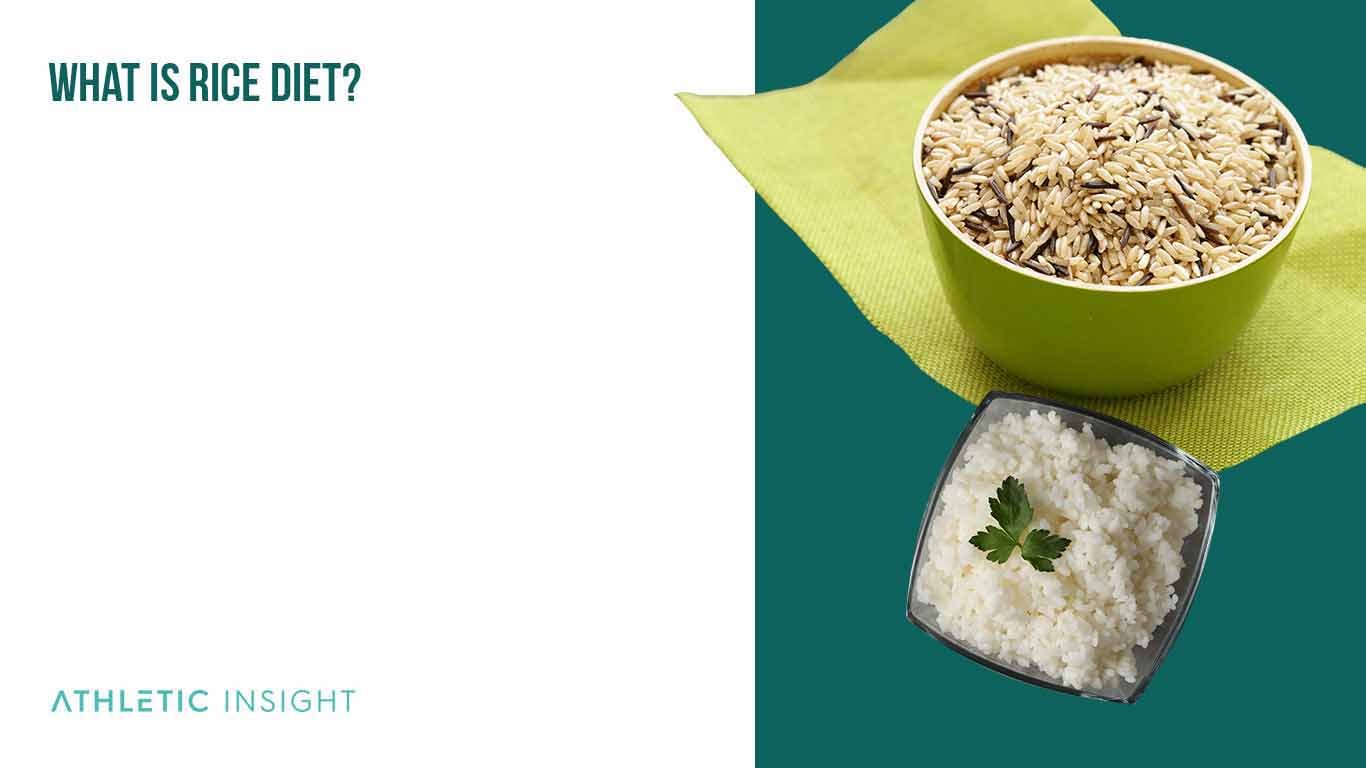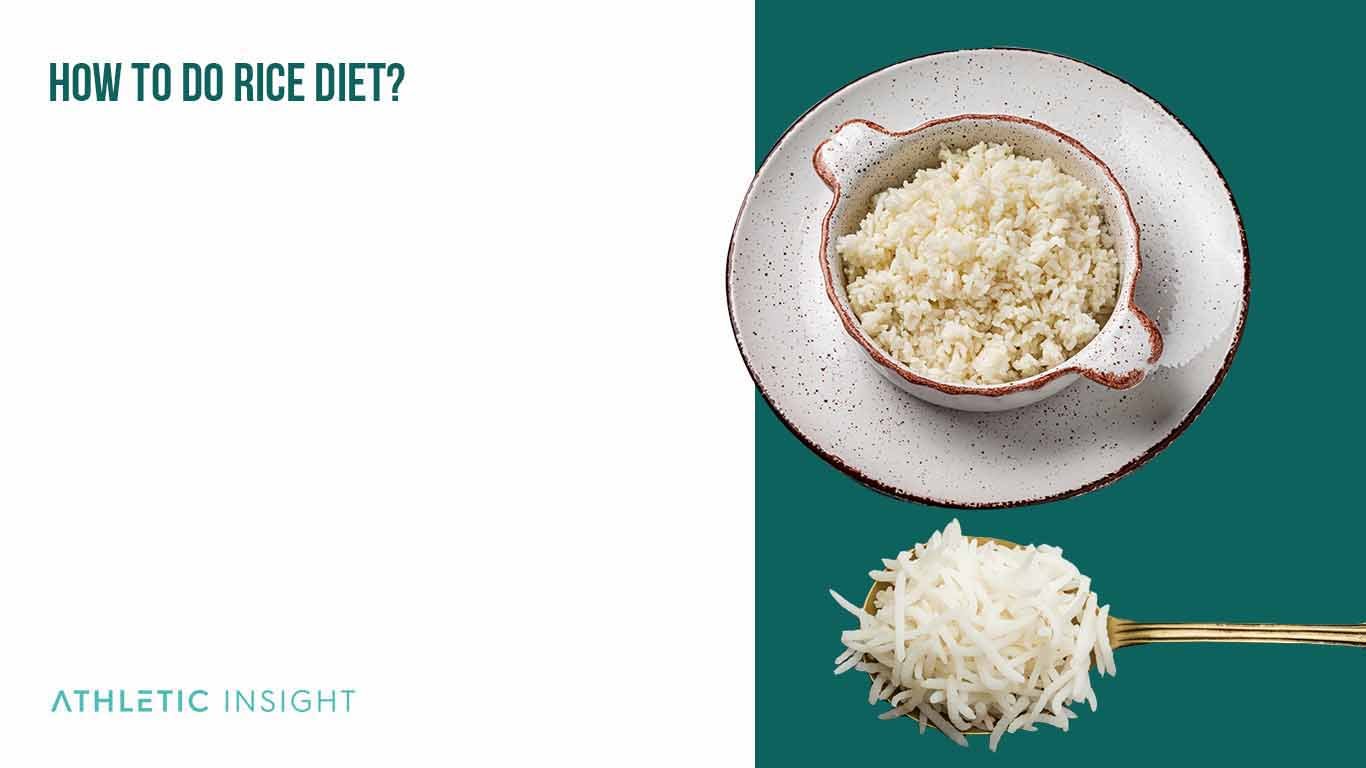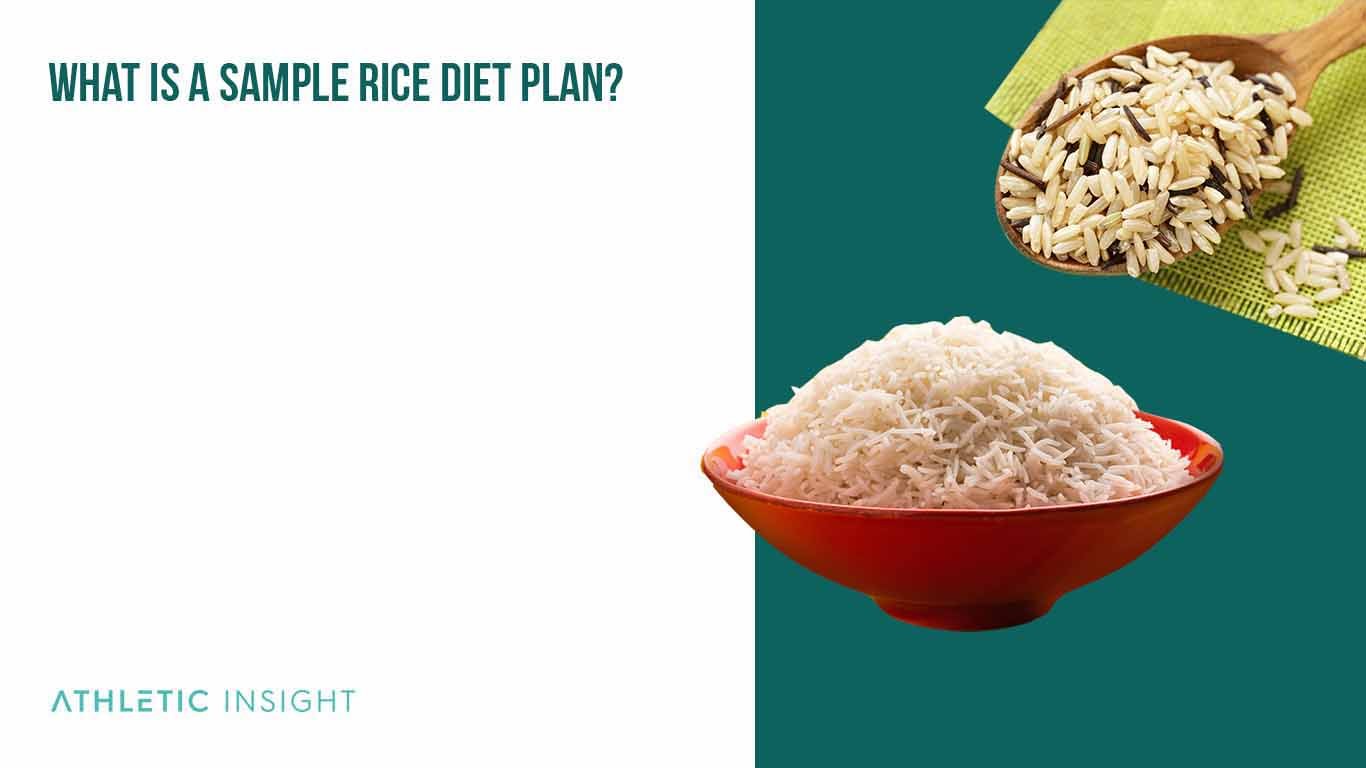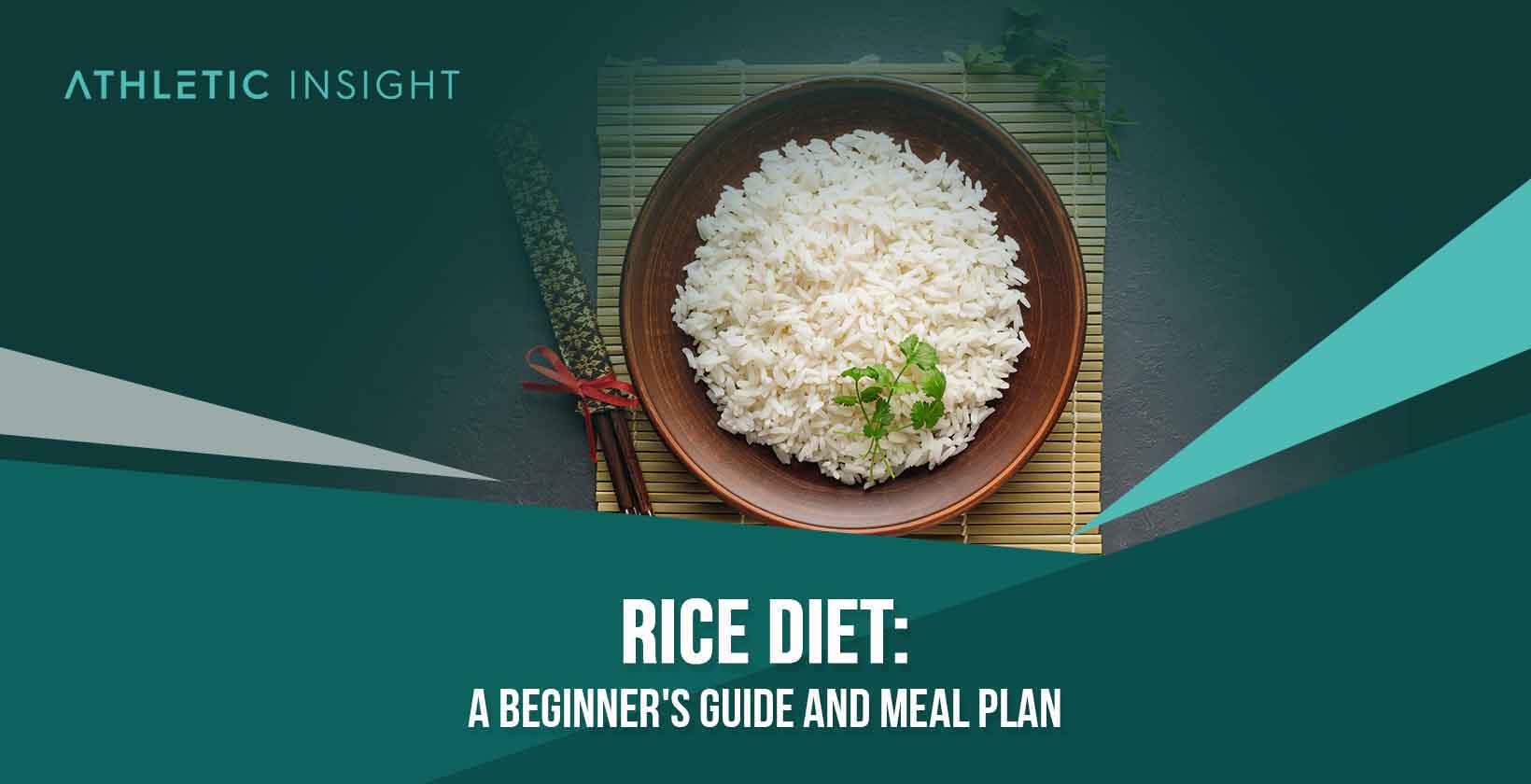The rice diet is a low-fat and sodium, high-carb diet that consists of eatng rice and rice-based meals. The rice diet is almost 100 years old but it recently came back into the public eye when Kitty Gurkin Rosati published the book, “The Rice Diet Solution,” in 2006.
The emphasis of this diet is limiting your body’s sodium intake. Sodium causes your body to absorb water which can cause bloating and excess water weight. By limiting the amount of sodium in your body, your body will shed excess water weight.
The rice diet also emphasizes the importance of low-fat foods and the need to avoid saturated fats. Fats can raise your harmful cholesterol levels, leading to an increased risk of heart disease and stroke. In addition to avoiding fats, the diet also restricts most dairy.
You can choose from several stages of the rice diet, depending on your health and the weight you would like to lose. Each stage includes different holistic practices you can implement to improve your dietary choices and behaviors. There is also an emphasis placed on exercise.
The rice diet has various health benefits, including improved digestion, cardiovascular health, and weight loss. For many, the diet is known as the rice weight loss method. However, talking to your doctor before beginning any new diet plan is essential.
If you are weighing the effectiveness of the rice diet, you have come to the right place. Please keep reading to learn everything you need about the rice diet, including its benefits, who it’s best for, what foods you should and shouldn’t eat, and a sample meal plan.
What Is a Rice Diet?
Walter Kempner created the rice diet in the 1940s to treat hypertension and renal failure through the consumption of rice and rice-based foods. Hypertension is a severe medical condition that, if left untreated, can lead to stroke and other health complications. Meanwhile, renal failure is damage to the kidneys that can lead to a buildup of waste products in the body.

The theory behind the rice diet is that changing diets and making different lifestyle choices can help your kidneys rest and recover. More recent studies have demonstrated that the rice diet is an effective treatment for hypertension and renal failure but also obesity and several other disorders.
What Is the Rice Diet Medical Abbreviation?
The rice diet medical abbreviation is RD or RSD, which stands for rice restriction diet. This diet got its name because rice was one of the primary food sources when Kempner initially experimented with it. He gave his patients a diet of white rice, sugar, fruit, juice, and supplements. The large amount of rice in this diet is where it gets its name.
How Does Rice Diet Work?
The rice diet works by reducing the amount of sodium and fat consumed. Sodium causes your body to absorb water, leading to excess weight and bloating. By reducing the amount of sodium in your diet, your body will shed this extra water weight.
Low-fat foods are also essential to this diet. Consuming too much fat can lead to an increase in harmful cholesterol levels, which can then lead to an increased risk of heart disease and stroke.
The rice diet primarily targets your kidneys and digestive system. Reducing the amount of sodium, animal protein, and dairy in your diet allows your digestive tract and kidneys to work less and will enable them to recover and heal themselves.
During the first week of the diet, you will notice some immediate changes. During the second and third weeks, you’ll see weight loss. Overall, the rice diet is a healthy and sustainable way to lose weight, improve kidney function, and reduce your risk of hypertension and other chronic diseases.
What are the Health Benefits of the Rice Diet?
There are a variety of health benefits to the Rice Diet such as weight loss, improved kidney function, improved heart health, decreased cholesterol levels, decreased risk of hypertension, reduced inflammation, lower blood pressure, improved digestion, improved energy levels, mental clarity, and protection from type 2 diabetes.
- Weight loss: The rice diet promotes weight loss through calorie restriction and reducing fats and sodium. The rice diet is commonly referred to as the rice weight loss method.
- Improved kidney function: The rice diet’s focus on reducing sodium and fats helps reduce your kidneys’ workload, allowing them time to heal.
- Improved heart health: Eating low-fat and low-sodium foods reduces heart disease and stroke risk.
- Decreased cholesterol levels: By reducing the amount of animal proteins and dairy in your diet, you can reduce your cholesterol levels.
- Decreased risk of hypertension: Eating low-sodium foods can reduce your risk of hypertension.
- Reduced inflammation: Foods high in antioxidants and fiber can help reduce overall inflammation.
- Lower blood pressure: Research has shown that the rice diet can reduce blood pressure levels.
- Improved digestion: Eating fruits and vegetables provides fiber, which helps improve your digestion.
- Improved energy levels: The rice diet provides a variety of nutrient-dense foods that can improve your energy levels.
- Mental clarity: Many patients reported improved mental clarity after following the rice diet.
- Protect from type 2 diabetes: The rice diet reduces your risk of type II diabetes due to its focus on healthy eating.
The rice diet is a healthy and sustainable way to lose weight and improve your overall health.
What are the Health Risks of the Rice Diet?
Despite its benefits, some health risks associated with the Rice diet include nutritional deficiencies, irritation and anger, nausea, weakness and lethargy, and loss of muscle mass.
- Nutritional deficiencies: The rice diet is low in proteins and fats, which may lead to dietary deficiencies. You may need to supplement the rice diet with vitamins and mineral supplements depending on your dietary needs.
- Irritation and anger: This diet is low in calories and may trigger irritability or anger when the body is deprived of essential nutrients.
- Nausea: Low-calorie diets can cause nausea, as the body lacks nutrition. However, this symptom often recedes as the body adjusts to this diet.
- Weakness and lethargy: Eating fewer calories can lead to weaker muscles and decreased energy levels.
- Loss of muscle mass: Due to the low-protein nature of this diet, you may experience some muscle loss due to the lack of protein.
How to Do a Rice Diet?
The rice diet is particular and restrictive. You need to follow these steps closely to maximize the effectiveness of the diet. If the name didn’t give it away, rice and rice-based foods will be the main meal for most of the diet.

- Reduce your sodium intake. Reducing the amount of salt you consume helps reduce water retention and flush out toxins from your body.
- Eat rice-based meals three times a day. You can cook plain rice or rice with vegetables, but the rice should remain the main focus of the meal.
- Reduce animal proteins and dairy products. Replace them with plant-based proteins such as legumes, nuts, and seeds.
- Eliminate alcohol from your diet. Alcohol can interfere with the rice diet’s effectiveness.
- Increase your intake of fruits, vegetables, and fibrous foods. These will provide essential nutrients and vitamins, as well as help aid digestion.
- Limit your consumption of saturated fats. Replace saturated fats with polyunsaturated and monounsaturated fats.
- Drink plenty of water. Staying hydrated helps flush toxins from your body and improve overall energy levels. You should drink at least two liters of water per day.
- Exercise regularly. Low-intensity exercises such as walking help burn calories and increase your metabolism.
- Incorporate other holistic practices into your lifestyle. Practice mindful eating, yoga, and meditation to reduce stress and improve your mental health. It would be best if you also took the time to understand portion control and the nutritional content of your food.
- Eat meals at regular intervals. Eating smaller and more frequent meals helps your body adjust to the rice diet and provides energy throughout the day.
In addition to following these rules, the rice diet is a three-stage diet that steadily increases calorie intake.
The first phase of this diet is detox. The purpose of this stage is to remove the sodium, toxins, and water weight from your body. This phase lasts one week, and you can only eat 800 calories daily. You should follow the essential rice diet one day per week, which includes two starches and two fruits for breakfast, lunch, and dinner. It would be best if you consumed a Lacto-vegetarian diet for the other six days, including starches, vegetables, and fruit.
The second phase of the diet is weight loss. The length of this phase depends on your weight loss goals. People who follow this diet closely lose around 3.5 pounds per week. The second stage bumps up your calorie consumption to 1000 calories daily. One day per week, you follow the basic rice diet. Five days a week, you follow the Lacto-vegetarian rice diet, and on the seventh day of the week, you can eat a vegetarian diet plus rice.
The final stage of the diet is maintenance. This stage aims to help your body adjust to your new weight and set a new reference point to keep your body weight stable. The calorie intake for this stage is 1200 calories per day.
As with the previous stage, one day per week, you eat the basic rice diet; four days a week, you eat a Lacto-vegetarian rice diet; and on the sixth and seventh days, you consume a vegetarian diet plus rice. In the final stage, you can begin incorporating more protein and healthy fats into your diet.
At the 1000-calorie stage, you should aim for 500-1000 mg of sodium, 22 g of fat, 5.5 g of saturated fat, and less than 100 mg of cholesterol. You can adjust these numbers based on the overall calorie consumption. If you are exercising, you should increase the calorie consumption of each stage by 200 calories.
Since the calorie reaction on this diet is intense, you should not follow this diet for more than six weeks. Following this diet for longer than two weeks can lead to serious health consequences and should be avoided.
While following the rice diet, there are some best practices you should follow to maximize the benefit of this diet.
- Consume a balanced diet: Aim to balance complex carbs, protein, and healthy fats. Consuming the proper nutrients helps keep your body nourished and energized.
- Manage your stress: Stress can lead to overeating and weight gain, which counteract the rice diet’s effects. Incorporating stress-relieving practices such as yoga and meditation can help.
- Increase your fiber intake: Fiber helps improve digestion and flush out toxins from your body.
- Get regular exercise: Aim for at least 30 minutes of low-intensity exercise daily. Low-intensity exercise can be a brisk walk, light jog, or bike ride.
What are the Foods that You can Eat While on a Rice Diet?
This Rice Diet food list includes many of the foods that you can eat while on the Rice diet.
- Fruits: apples, oranges, pears, grapes, bananas, watermelon, and mango
- Vegetables: broccoli, kale, spinach, tomatoes, cauliflower, carrots
- Grains: whole grains like rice, quinoa, oats, and barley
- Legumes: lentils, chickpeas, kidney beans, and black beans
- Nuts:
- Seeds:
- Healthy fats:
- Proteins: lean protein like fish and chicken
Overall, the rice diet is an effective way to kick-start weight loss. These foods are important because they are low in fat and sodium.
What are the Foods that You Should Avoid While on a Rice Diet?
The rice diet is highly restrictive, and you are not to eat these foods under any circumstances.
- Meat: steak and pork
- Poultry:
- Fish and shellfish:
- Meat-based ingredients: deli meat, sausage
- Eggs:
- Dairy products: whole-fat dairy products like sour cream and whole milk
In addition to these foods, you need to avoid processed sugar, processed foods, and refined four. You should avoid these foods because they contain unhealthy fats and added sugar which can cause weight gain.
Who Should Do a Rice Diet?
The rice diet is a low-calorie diet that can benefit those who want to lose weight. It can also help with weight maintenance. It is also suitable for diabetes, high blood pressure, and high cholesterol. The rice diet is helpful for people with diabetes, high blood pressure, and high cholesterol because it is low in fat, sodium, and sugar.
The rice diet is also attractive to people looking for a holistic diet that touches on other parts of their lifestyle. While lifestyle changes make this diet harder to follow, it increases the chances of keeping the weight off for good.
The rice bodybuilding diet is not appropriate for weight lifting or weight training. The diet does not have enough protein and healthy fats to support muscle growth and strength gains.
The rice diet may not be suitable for pregnant women, breastfeeding mothers, and young children. Ultimately, the rice diet is suitable for those who need to lose weight and are willing to commit to a strict diet.
How Easy Is a Rice Program to Follow?
The Rice program is not an easy one to follow. It is highly restrictive and requires you to follow the rules closely if you want to reap the benefits.
Additionally, the rice diet is incompatible with eating out, so you must make most of the meals at home and avoid eating out with friends and family.
You will also have to get used to not eating the usual staples you may be used to, like sweet snacks and fried food.
What Is a Sample Rice Diet Plan?
This sample rice diet plan is an example of what you will eat in one week. Remember, the menu items will change depending on what phase of the diet you are on.

Day 1
- Breakfast: oatmeal with fresh fruit and chia seeds and a cup of tea
- Lunch: a cup of white rice and stir-fried vegetables
- Dinner: grilled vegetables and mushroom risotto
Day 2
- Breakfast: a slice of whole wheat toast, avocado, and unsweetened tea
- Lunch: a cup of brown rice with grilled vegetables
- Dinner: vegetables and brown rice with grilled fish
Day 3
- Breakfast: vegetable quinoa and fresh fruit
- Lunch: grilled chicken, brown rice, and fresh fruit
- Dinner: chicken and mushroom risotto
Day 4
- Breakfast: oatmeal with strawberries and an orange
- Lunch: asparagus, cooked rice, and black beans
- Dinner: quinoa and sliced fruit
Day 5
- Breakfast: toast with raspberries and low-fat Greek yogurt
- Lunch: cooked rice with beans, celery, and carrots
- Dinner: brown rice with grilled chicken
Day 6
- Breakfast: a banana with whole-grain cereal and low-fat milk
- Lunch: brown rice with beans and fresh fruit
- Dinner: green beans, cabbage, and salmon with brown rice
Day 7
- Breakfast: french toast and fresh fruit
- Lunch: vegetable and quinoa salad
- Dinner: savory rice with tomatoes and vegetables.
What are the Best Recipes for a Rice Diet?
These are some of the best recipes for the Rice diet.
- Perfect brown rice: Since rice is such a large part of this diet, cooking rice in a rice cooker is a great way to improve the quality of the food.
- Savory rice with tomatoes: Stewed tomatoes and rice is a great way to add flavor but no calories to your rice.
- Grilled Chicken: Grilled chicken is the perfect lean protein for this diet.
- Rice and beans: Rice and beans will be one of the staples of the rice diet.
- French toast: WHole-grain french toast is a great breakfast item.
What are the Best Types of Rice for a Rice Diet?
The most popular varieties are jasmine rice, basmati rice, and brown rice. However, brown rice is the best for this diet because it is whole-grain rice, which is higher in fiber and other essential nutrients.
What are the Facts About the Rice Diet?
You should know some essential facts about the rice diet, including what happens in the first week, weight loss, approved foods, benefits, and length of the diet.
- The first week: The first week is the most challenging part of the rice diet. You will be hungry, and you may experience headaches and fatigue.
- Weight loss: You can expect to lose an average of two to three pounds per week on the rice diet because it is low in saturated fat and cholesterol.
- Approved foods: The rice diet requires you to eat rice, vegetables, fruits, lean protein, and healthy fats.
- Benefits: The rice diet can help you lose weight, reduce cholesterol, improve digestion, and increase energy levels.
- Length: Most people follow the rice diet for at least three weeks.
How Much Does the Rice Program Cost?
The rice program is cheap and does not cost anything to follow besides the ingredients.
What are the Alternatives to the Rice Diet?
There are many alternatives to the rice diet such as the DASH diet, Ketogenic diet, Whole30 Diet, and the Mediterranean diet.
- DASH diet
- Ketogenic diet
- Whole30 diet
- Mediterranean diet
What Does a Rice Diet PDF Involve?
A rice diet PDF typically consists of detailed information about the rice diet, including an overview of the rice diet, guidelines for rice preparation, the best foods to eat on the rice diet, a meal plan, and recipes.
How to Find a 3D Rice Diet Printable Plan?
3D rice diet printable plans are available online. Just do a quick search on the internet, and you will find plenty of websites that offer one.
Is Rice Good for a Diet?
Yes, rice is suitable for a diet because it has low calories and is a good energy source. Plus, rice has plenty of vitamins and minerals.
Is Chicken and Rice a Good Diet?
Yes, a chicken and rice diet is a great choice. Chicken is a lean protein source, and rice is low in calories, making it an ideal meal for those looking to lose weight. Just make sure not to add too many oils and fats when cooking.



